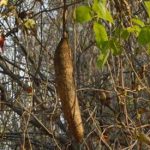TREE LIFE
483
November 2020
After many months of inactivity due to the Corona-19 pandemic we are going to resume the tree outings in a low key.
November Saturday 7th 2020, Time: 08:30-10:00; National Botanical Garden, Harare. Join us for an interesting and informative walk in this amazing garden. There is always something of interest. We will start at 08:30am from the usual place – the car park. To keep our group(s) small, only members are invited to this outing. Reminders will be sent by email as usual!
First Tree Outing since March 2020 (Trial walk)
The last Tree Society of Zimbabwe tree outing was to Bushman’s Rock on Sunday 15th March 2020. That was over half a year ago and I know that several of our members have been itching to go on another tree walk for some time. BirdLife Zimbabwe resumed their bird walks a few months ago, birders also get together in groups in woodlands and other habitats so why can’t tree enthusiasts do the same? With this in mind, I organized a tree outing for just four of us just to see how this would pan out.
On Sunday 11th October, Meg Coates Palgrave, Mark Hyde, Jan van Bel and myself met at the National Botanical Garden at 8:30 am for the trial tree outing. At the end of the outing, we agreed that we could resume our tree walks but do them low key. To keep groups small, we should only invite our members and not advertise any of our outings to non-members. Strangely enough, even though we have not had any recent outings, we have actually gained a few new members and it would be great to meet them.
Not having visited the National Botanical Garden for some seven months, the first impression was shock at just how dry many trees looked without their leaves. However amongst them, there were quite a few in new leaf.
Mark had expressed a wish to look at the Strophanthus species as they ought to be in flower at this time of the year. So the first call was to the Strophanthus kombe. Kombe tail-flower located next to the bamboo clump Dendrocalamus giganteus. Giant bamboo close to the desert house. The first thing we noticed was that the bamboo stand appeared to be dying, on closer inspection we saw that although the large old bamboo culms, sticks or poles were dying, there were quite a few new shoots of varying sizes growing so the assumption is that all the culms that were dying had already flowered.
Well, we were in luck, the Strophanthus kombe had just started flowering with many new buds to be seen.
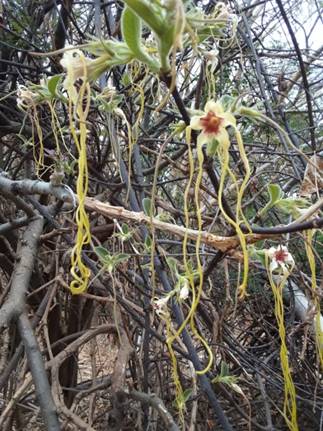
Strophanthus kombe – photo by Tony Alegria
We then set off to look at what had been identified a few years earlier as the Strophanthus speciosus. Forest tail-flower. En route we looked at Artabotrys brachypetalus. Purple hook-berry with many buds. The Rothmania manganjae had already flowered and there was new fruit along with old fruit from the previous year on the tree. The Ficus bubu had a few white spotted figs on short stalks. The Newtonia buchananii and Breonadia salicina looked like they hadn’t seen any water for a long time, however the Xanthocercis zambesiaca. Nyala berry was very green and had young fruit. It was also noted that the Sausage trees had already flowered – the evidence was on the ground! When we reached the second Strophanthus, we were rather disappointed as there wasn’t a flower to be seen, just a few banana shaped fruit on the bush.
We then went next to the Herbarium to look at the Albizia schimperiana which was in flower with loads and loads of buds. The small leaflets resemble the Albizia gummifera in shape but are not so rectangular and have two distinct veins from the base. Also noted was that the Trichilia emetica and T. dregeana both had buds which is rather unusual – they normally flower at different times of the year.
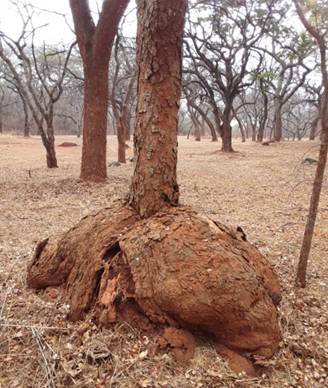
Swollen base tree – Photo by Tony Alegria
We noticed that the one and only Bauhinia grandidieri had died, This tree is number 277 on the list of labelled trees thus the number had to be used elsewhere and we selected a nearby small tree with rather strange fruit to be the new tree number 277. Thus the original list which was emailed to all members needs to be amended. However, Jan and I are currently working on adding the next 25 trees to the list. When completed, it will be emailed to our members with any amendments.
Slowly we progressed and saw many trees and then we came across a tree with a very swollen base which could have been a leafless msasa.
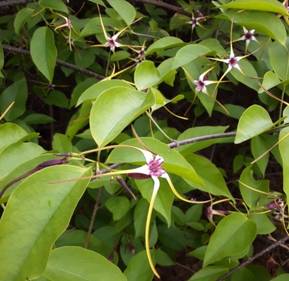
Unknown Strophanthus – photo by Tony Alegria
Eventually we reached the third Strophanthus nearer the National Parks side of the gardens. Here we found quite a few plants, two of which had climbed to the top of the trees and they were in flower – in fact, lots of flowers! We failed to identify the species of Strophanthus.
On the way back to the cars it started raining, not heavy stuff but certainly enough to get us soaked! Of course, when we began our walk, the sky had been overcast and so it remained till we left. It really was great to be amongst the trees again with like minded people.
Tony Alegria
Rudolf Marloth (1855-1931)
Plant enthusiasts might have seen the name ‘Marloth’ in connection with different kind of plants; e.g. Commiphora marlothii, Rhus marlothii, Euphorbia marlothii, Aloe marlothii, Disa marlothii etc. According to Harms (1933) there are also 3 genera named after him; namely Marlothia Engler 1888 (Rhamnaceae), Marlothiella Wolff 1912 (Umbellifereae) and Marlothistella Schwantes 1928 (Aizoaceae). This diversity reflects on the collector who never focused on a particular group of plants.

Rudolf Marloth in his 70s
Rudolf Marloth was born in Lübben in north eastern Germany (Prussia at that time) and studied pharmacy in Berlin. In 1883 he obtained his doctorate on a botanical thesis (‘The mechanical protection of seeds against harmful influences from outside’). The same year he moved to South Africa because he was encouraged by the reports of a school friend who had successfully settled in Cape Town. After the discovery of the Kimberley diamonds in 1870, the British Cape colony had become a ‘melting-pot’ and attracted immigrants of many different nationalities.
Marloth first took up an employment as a chemist, but soon started his own pharmacy business. In addition, lectured at various institutes of higher learning. In 1889 he established a laboratory for analytical chemistry and pharmaceutical research in Cape Town. It played an important role to improve the utilisation of natural resources. For Marloth it was an economic niche which eventually made him wealthy.
Although chemistry was his profession and brought him his livelihood, he is first and foremost remembered as a botanist. According to Hutchinson (1931), “Marloth was the last of a small circle of SA botanists whose activities were greatest towards the close of the century. Although more or less contemporary with Bolus, MacOwan and Medley Wood, his work shows ample evidence of more modern methods of botanical research. Where Marloth differed from them was mainly in his field work. Although sometimes an indifferent collector, he was a very acute observer of plants in the field and of all biological phenomena connected with them. Together the so-called ‘big four’ gave botany a position of importance in South Africa it had not had before.
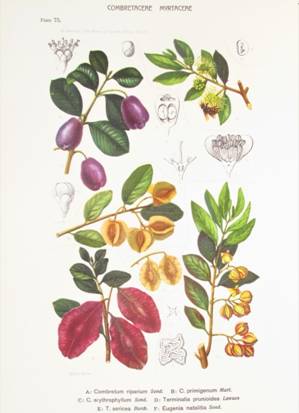
Plate 75 from Marloth’s Flora of South Africa Vol. 2(2), 1925
Marloth was enormously productive and according to Gunn/Codd (1981) “produced a number of papers on a wide range of subjects, such as plant adaptation and mimicry, phytogeography, ecology, ethnobotany, economic botany and the teaching of botany. But the work for which he is most widely known is his Flora of South Africa which appeared in six magnificently illustrated volumes over the period 1913-32.”
An important ingredient in this work was hand-painted colour plates. As colour printing was in its infancy in those years, these parts of the books had to be printed in Europe. Such a costly work was made possible only by the generous support by some members of the South African business community. In the Gardeners’ Chronicle it was commented a “pioneer work, for there is nothing similar to it, at least so far as relates to extra-European floras”.
In addition, Marloth is often mentioned as a plant photographer. Through the advancement in technology it can easily be forgotten, that a century ago his photographic style was more or less revolutionary – to photograph plants in their typical habitats. In other words, his photography was ahead of his time.
About Marloth it is said that the day after his arrival in Cape Town he climbed Table Mountain. He was untiring in his search for the mountain flora because it was on the upper parts of the highest mountains that new and interesting species were to be found. He combined botanising with mountaineering and subsequently, he was a foundation member of the Mountain Club of South Africa in 1891, and its chairman from 1901-06. (Maybe the mountains fascinated him because his native Brandenburg was an extremely flat country.)
The itinerary of his botanical expeditions is numerous and included some neighbouring countries.
With advancing age Marloth was highly honoured in South Africa and his native Germany. For example, honorary doctorates were conferred upon him by the universities of Stellenbosch (1922), Heidelberg (1929) and Cape Town (1929). In addition he was honoured by the scientific societies which he actively supported (and are too numerous to be named here).
References
Gunn, M. & Codd, L.E. (1981): Botanical Exploration in Southern Africa. Balkema, Cape Town
Harms, H. (1933): Rudolf Marloth. Berichte der Deutschen Botanischen Gesellschaft 51: 220-230
Hutchinson, J.H. (1931): Dr. Rudolf Marloth. Bulletin of Miscellaneous Information (Kew) 1931: 427-428
Werner Fibeck
The chittering tree of the Vumba Botanical Garden
It was late afternoon by the time we reached our destination. A breakdown near Mutare had scuppered plans to get to the Vumba Botanical Garden much earlier. A struggle to find a signal to pay our entry fee with EcoCash delayed us further.
My hopes of exploring the evergreen forest to find a suitable candidate for Tree of the Month were quickly receding. There would only be time to see the manicured part of the garden, which is filled with exotic species.
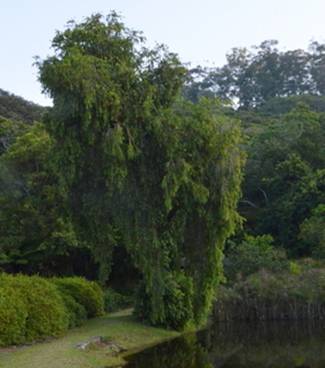
Callistemon viminalis tree Photo by Ryan Truscott
Arriving late did have its benefits though. We had the place to ourselves. As the sun slipped behind the hills, the glassy surface of the lake was only rippled by the odd Eastern saw-wing swallow dipping down to collect water or insects.
It was while walking along the dam wall that I came upon the chittering tree: a Weeping bottle-brush, Callistemon viminalis covered with crimson flowers.
The tree has stood there for as long as I can remember. It was there back in 1987 when, as an awkward teenager, I slipped away from a Saturday afternoon visit to the tearoom with my brother and his girlfriend to go and explore the garden and saw my first Swynnerton’s robin. The bird — a small amber jewel with a white crescent on its throat — appeared momentarily on a pathway in the forest.
Now, 33 years later, the bottle-brush tree was alive with the excited strident piping of a dozen birds, but I could not see a single one. They were invisible.
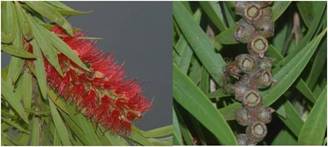
All I could do was stand there and listen in awe to the sound as my wife and daughter went off to explore another part of the garden.
I have a childhood memory of my parents cutting down two Weeping bottle-brush trees that grew outside the front gate of our home near Mutare. I had always thought that was because they disliked the species, which is native to Australia. But when I reminded them about it recently, they said that someone without foresight had planted the trees in a place with no water. The trees had grown into poor, scraggly specimens that needed to be replaced.
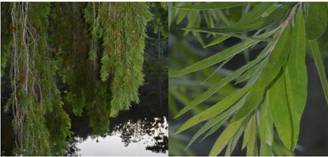
Callistemon viminalis branches & leaves Photos by Ryan Truscott
The bottle-brush in the Vumba garden is perfectly situated. Its roots at the water’s edge are constantly moist; its drooping branches, with their lanceolate leaves, hang down to the lake surface.
The abundant flowers, which are present throughout the year, are what give the tree its scientific name: Callistemon is derived from the Greek word, kallistos, which means “most beautiful”. The tree is famously attractive to nectarivores: bees, butterflies, birds.
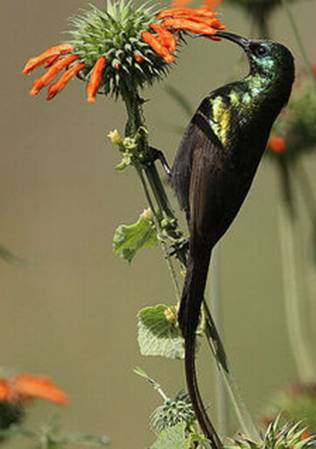
Bronze sunbird Photo by Steve Garvie (Wikimedia Commons)
And here, in the Vumba Botanical Garden, it was attracting a great many birds, but which ones? In the gathering dusk I was resigned to not finding out. So, I occupied myself instead with using my flash to take pictures of the flowers and the woody fruit capsules.
Finally, I noticed a movement high up in the branches and quickly fixed my binoculars on it.
Ah… a Bronze sunbird. In Zimbabwe they are only found in the Eastern Highlands. The males are dark, with an iridescent bronze sheen and a tail whose central feathers are distinctively elongated. The birds are said to be regular visitors to the flowers of Erythrina trees and aloes. But there must have been at least a dozen of them congregated around this exotic cornucopia of flowers and nectar.
Next time you visit the garden, be sure to go and stand beneath the chittering tree and marvel at the sound in its branches.
Ryan Truscott
Obituary – Lola Irvine
With a changing membership, sadly past members of the Tree Society, even very active ones are often forgotten and just fade away.
On Oct 11 2020, Cheryl Haxen wrote on the Tree Society Facebook Messenger: Just to let you know that Lola Irvine who along with her husband Doug was a prominent member of the Tree Society for many years died yesterday in Brisbane Australia, aged 96. Philip and I were fortunate to catch up with her from time to time as one of her sons lives near us. She loved to talk about the tree walks in Zimbabwe and had become just as interested in Australian flora. She recently created a book about her paintings which were beautiful studies of flowers. All four of her sons live in Queensland so she has had many years close to all her family. We were fortunate to have been at her 90th birthday celebration and recently had a walk in a botanic garden near her Toowoomba family. Farewell to a great talented and humorous lady. Truly a full life well led.
Kim Damstra followed up with: Thanks for writing that Cheryl. When I arrived, Lola was one we turned to when we were stuck with identification. Such a lady.
Mark Hyde – Yes thanks for posting. I don’t remember her- before my time in Tree Society, I think.
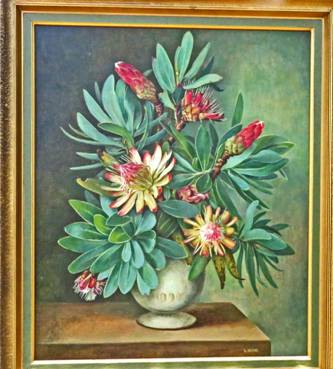
Painting by Lola Irvine Photo by Meg Coates Palgrave
Lola Irvine and her husband Douglas were very active members of the Tree Society when Paul and I first became members in the late 1970s.
Before they left for Australia, they visited Nyanga when the Protea to the right was flowering and I proudly hang the painting on my wall.
They moved to Australia in the mid 1980s and I was sad to see them go. Apart from their interest in and knowledge of trees which they so willingly shared with us they also became personal friends.
I am also the proud owner of Doug’s copy of the Rhodesian Botanical dictionary with all his notes.
Lola was a lovely person and a special friend from long ago and far away.
Meg Coates Palgrave
Jacaranda Time!
Yep, it’s that time of the year again when the Jacaranda trees are in flower. Keep your eyes open and if you see any White Jacarandas that are not listed below, please let me know where they are. One stipulation, these trees must be visible from the road so anyone can see them.
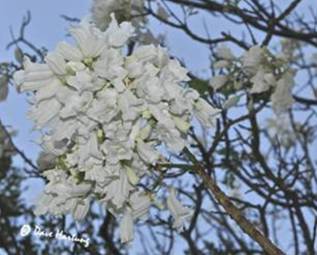
White Jacaranda Flowers Photo by Dave Hartung
Locations of White Jacarandas:
Two street trees, with one purple in-between them along Samora Machel opposite the Tel-One College. They are in front of properties 148 & 152 Samora Machel Ave.
One street tree on Piers Road opposite Bon Marche in Sam Levy’s Village.
One tree in a garden on 195 Enterprise Road opposite the Chisipite shopping centre.
One street tree at 155 Baines Ave. between Sixth and Seventh Streets.
One tree close to the road in the property of 41 Ridgeway North.
One tree in Harare Gardens behind Livingstone House.
I’d like to know about any White Jacaranda trees anywhere in Zimbabwe so they can be listed on our website.
Tony Alegria
Tony Alegria – Chairman


